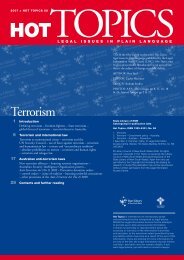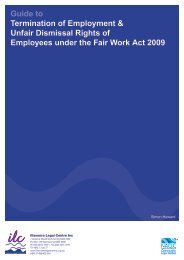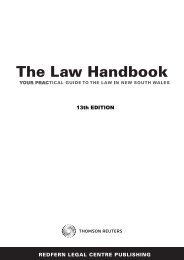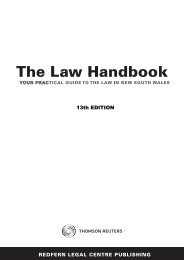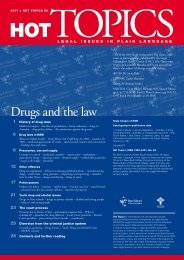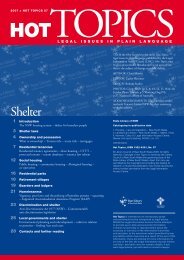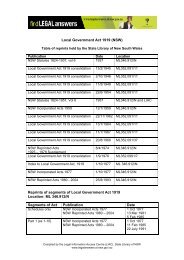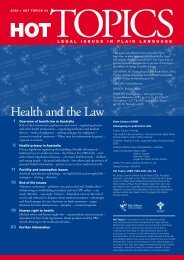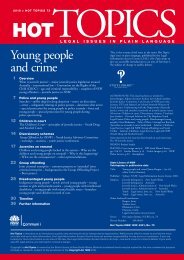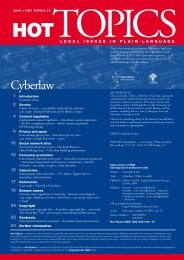Prisoners - Legal Information Access Centre - NSW Government
Prisoners - Legal Information Access Centre - NSW Government
Prisoners - Legal Information Access Centre - NSW Government
Create successful ePaper yourself
Turn your PDF publications into a flip-book with our unique Google optimized e-Paper software.
On 30 June 2007, 2.3 million prisoners were held in<br />
US federal or state prisons or in local jails. 48 In 2004,<br />
nearly 7 million people were on probation, in jail or<br />
prison, or on parole – 3.2% of all US adult residents or<br />
one in every 31 adults. 49 As with the over-representation<br />
of Aborigines in Australia (discussed previously) there is<br />
a striking racial imbalance in the US prison population.<br />
Black males are imprisoned at six times and Hispanic<br />
males nearly three times the rate of white males. In the<br />
25-29 years age group, 8.4% of black males were in State<br />
or federal prison, compared with 2.5% of Hispanic males<br />
and 1.2% of white. 50 The Sentencing Project calculated<br />
that one in nine African-American males aged 20-29 are<br />
in prison at any one point in time and one in three are<br />
either in prison or on probation or parole.<br />
Mass imprisonment?<br />
Such statistics have resulted in leading criminologists<br />
analysing the US situation as one of ‘mass imprisonment’,<br />
defined as when imprisonment ‘is markedly above the<br />
historical and comparative norm for societies of this<br />
type’ and ‘ceases to be the incarceration of individual<br />
offenders and becomes the systematic imprisonment<br />
of whole groups of the population’. 51 In this situation<br />
imprisonment:<br />
becomes part of the socialisation process. every<br />
family, every household, every individual in these<br />
neighbourhoods has direct personal knowledge of<br />
the prison – through a spouse, a child, a parent,<br />
a neighbour, a friend. imprisonment ceases to be<br />
the fate of a few criminal individuals and becomes<br />
a shaping institution for whole sectors of the<br />
population.<br />
The social and financial costs of mass imprisonment<br />
are acute:<br />
Reduced state budgets for other spending; the<br />
alienation of whole sectors of the population; the<br />
normalisation of the prison experience and the<br />
transfer of prison culture into the community;<br />
the criminogenic* consequences of custody for<br />
inmates and their families and their children; and<br />
the disenfranchisement of whole sectors of the<br />
community.<br />
*Criminogenic = crime-producing<br />
From 1925 to 1975 the US imprisonment rate was around<br />
110 per 100,000 population, increasing suddenly with<br />
the ‘war on drugs’, ‘three strikes’ laws and mandatory<br />
minimum sentences. 52 Between 1970 and 2005 there<br />
was a 628% increase in the US prison population. 53<br />
scAndinAviAn cOunTries<br />
The Scandinavian countries of northern Europe: Sweden,<br />
Norway, Denmark and Finland are a group of countries<br />
which historically have enjoyed low imprisonment rates.<br />
According to a study by John Pratt, the origins of low<br />
imprisonment rates and exceptional prison conditions<br />
can be found in cultures with a history of equality. The<br />
welfare state was particularly strong in the Scandinavian<br />
countries, institutionalising high levels of trust and<br />
solidarity through the provision of state-guaranteed<br />
security. Pratt identifies the following characteristics of<br />
low imprisoning countries:<br />
> strong state bureaucracies with significant autonomy<br />
and independence from political interference;<br />
> mass media largely controlled by public neo-corporate<br />
organisations rather than market forces … providing<br />
its already well informed public with objective rather<br />
than sensationalised crime knowledge;<br />
> traditions of social welfarism which reduced<br />
criminogenic tendencies and led to a less severe<br />
punishment mentality;<br />
> high levels of social capital;<br />
> and the power and influence of expertise. 54<br />
Pratt sees these characteristics as coming under threat<br />
through welfare restructuring, immigration, declining<br />
levels of security and solidarity, and the ‘growth of<br />
intolerance and punitiveness against outsider groups’. 55<br />
Nevertheless such comparisons ‘tell us that there are<br />
other choices available to us in how to respond to crime<br />
and how to manage prisons’. 56<br />
48. US Department of Justice, Bureau of Justice Statistics, Prison Statistics, http://www.ojp.usdoj.gov/bjs/prisons.htm accessed 18/9/2008.<br />
49. US Bureau of Justice Statistics, Bulletin October 2005 1-2.<br />
50. J Walker (see Note 37).<br />
51. David Garland, ‘The meaning of mass imprisonment’, (2001) 3(1) Punishment and Society 5-6.<br />
52. Christopher Shea, ‘Life Sentence: How Prison is Reshaping the USA’ (2007) The Boston Globe 24 September.<br />
53. D Steman, Vera Institute of Justice, New York, Reconsidering Incarceration (2007) 1; available at http://www.vera.org/publication_<br />
pdf/379_727.pdf<br />
54. As above at p 135.<br />
55. John Pratt, ‘Scandinavian Exceptionalism in an Era of Penal Excess’, Part 11: Does Scandinavian Exceptionalism Have A Future?’ British<br />
Journal of Criminology (2008) 48, 275-292 at 288.<br />
56. As above at p 290.<br />
10<br />
HOT TOPICS 67 > <strong>Prisoners</strong>



